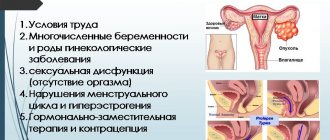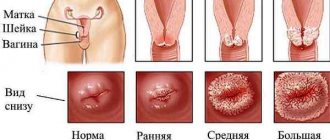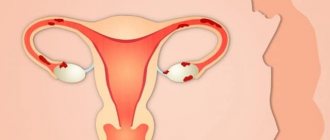Endometriosis is one of the most common gynecological diseases affecting women of reproductive age. These are mainly women in the age range from 20 to 44 years. If symptoms of cervical endometriosis appear in women, it is better to entrust treatment and all related examinations to a doctor, he will conduct additional examinations and make an accurate diagnosis. Of course, any doctor, if this disease is detected, will offer conservative drug treatment. But only a doctor should prescribe it. The Internet, women's forums are auxiliary information. You only need to trust your health to a specialist who will help you choose the right medications for endometriosis.
The most effective suppositories for endometriosis
The female body is often affected by endometriosis.
This disease is characterized by the growth of the mucous membrane outside the uterus. It is caused by hormonal imbalance. If a disease of the reproductive system is discovered late, then it can only be dealt with through surgery. But at the initial stage, suppositories for endometriosis may well help. They are prescribed by the attending physician to combat the disease as part of complex therapy.
Suppositories as a dosage form
Doctors often prescribe suppositories that are inserted both anally and vaginally. As a rule, they relieve pain, have anti-inflammatory, antitumor effects and have an antiseptic effect.
If pathology occurs on the cervix and vagina, then vaginal suppositories will be most effective, since they directly interact with the lesions.
The advantage of suppositories as a medicine is that the components of the drug enter the bloodstream and to the site of action, bypassing the stomach and intestines, without harming the mucous membrane of these organs and without loading the liver.
Recommendations
In addition to the indications for use indicated in the annotation, doctors quite often recommend ichthyol suppositories as a softening drug for constipation.
It is advisable to use the product under the following circumstances:
- prolonged constipation;
- inability to use other medications;
- pelvic weakness or bowel weakness.
The drug is used in many areas of medicine both for the treatment of pathologies and for prevention. In a sense, the drug can be called universal, capable of eliminating many problems in a short time.
What suppositories are used in the treatment of endometriosis
Vaginal suppositories are used infrequently for the treatment of endometriosis, because this disease is characterized by menstrual irregularities with frequent unexpected bleeding, which washes the active ingredients out of the vagina. As a result, the beneficial effect is not achieved.
But the effect of rectal suppositories is much more effective, they are quickly absorbed, and also:
- remove inflammation;
- help damaged uterine tissues heal faster;
- increase the immunity of the pelvic organs;
- prevent infection from developing.
The course of treatment is prescribed by the attending physician in combination with other medications prescribed in the form of tablets and injections.
Anti-inflammatory and painkillers
To relieve pain, gynecologists recommend:
- Diclofenac. It is administered rectally once a day. Do not use during pregnancy.
- Indomethacin. The gynecologist individually selects a course of treatment with suppositories to combat endometrial pathology. After achieving a positive effect, the doctor adjusts the dosage. Providing an analgesic effect, the drug does not disturb the vaginal microflora.
- Anuzol. Suppositories are inserted into the anus once or twice a day.
- Longidaza. Anti-inflammatory gynecological suppositories also work well against adhesions and prevent their formation.
- Endometrin. The drug restores normal hormonal levels.
Regular use of such suppositories for endometriosis not only relieves pain, but also reduces the manifestations of inflammation.
Hormonal
Since the disease occurs against the background of a lack of the hormone progesterone in the body, suppositories are successfully used to treat endometriosis, replenishing the deficiency of this biologically active substance. The most effective and frequently used:
Any of these medications is prescribed exclusively by a doctor familiar with the woman’s medical history.
To combat adhesions
Often, during the course of the pathology, adhesions form in women. As a result of this process, the fallopian tubes are damaged. This can lead to ectopic pregnancy or infertility. The use of Longidaza rectal or vaginal suppositories helps stop the formation of new ones and get rid of existing adhesions. For endometriosis, such suppositories are placed at night once every two days. 10 pieces are required for the course. The method of administration is determined by the attending physician.
To strengthen the body's immune system
Endometriosis greatly weakens the body. To restore not only local, but also general immunity and increase the resistance of organs and tissues to infections and bacteria, rectal suppositories were developed. They contain human interferon and have almost no contraindications. Such drugs include:
These medications also have an antiviral effect. They must be used strictly following the doctor's recommendations.
Useful video
To learn how to properly insert suppositories rectally, watch this video:
Different endometritis also requires different treatment. Methods of therapy, regimens for the treatment of chronic and acute, postpartum and autoimmune, purulent will be slightly different. Although the drugs may be the same.
Acute endometritis develops due to infections. It can be purulent, catarrhal. The reasons may lie in abortion, examination procedures, and sometimes postpartum. Symptoms: fever, chills, pain. The treatment is long-term, antibacterial.
One of the effective remedies is suppositories for vaginitis. They are selected depending on the shape and type. What are needed for treatment of bacterial, atrophic, acute, mixed? Which ones will be the best and most effective during pregnancy?
In combination with medications, physiotherapy for endometritis helps to get rid of the problem as quickly as possible. Treatment may include both a set of procedures (especially important in the chronic form) and certain influences.
Advantages and contraindications
Among the advantages of vaginal suppositories, as mentioned above, are:
- rapid absorption of the active substance into the blood and tissues of the affected organ;
- no negative effect on the stomach, intestinal tract and liver.
But suppositories, like other medications, have contraindications and side effects. Contraindications most often include:
- first trimester of pregnancy;
- lactation period;
- disorders of the liver or kidneys;
- allergy to any of the components of the drug;
- tachycardia.
Each drug has its own contraindications, so be sure to read the instructions before using them. And only a specialist with appropriate education can prescribe medications.
Side effects usually include:
- allergic manifestations;
- constipation or diarrhea;
- headache;
- insomnia;
- urinary retention;
- convulsions.
If any of the symptoms appear, you should consult your doctor.
Types of suppositories for the treatment of pathology
For diseases of the uterus such as endometriosis, various types of suppositories are used as an auxiliary treatment. They are selected by the doctor depending on the woman’s condition.
The most effective and most frequently prescribed suppositories for endometriosis: Longidaza, Indomethacin, Viferon, Galavit, Terzhinan, Antikan.
These drugs are used if the disease has been caught at an early stage. In case of a complex course of the disease, hormonal therapy and surgery are prescribed.
Suppositories with propolis
As a rule, a gynecologist prescribes suppositories with propolis for severe pain. At the same time, the active ingredient of the drug works as an antiseptic, thereby protecting the weakened organ from infection.
Suppositories are also often used after surgery to make healing faster and less painful.
Sea buckthorn
They help well with the internal form of endometriosis. The use of sea buckthorn suppositories has a beneficial effect on the mucous membrane of the uterus and vagina. They have a hemostatic, antispasmodic and anti-inflammatory effect. But they can also cause allergies, so they are used with caution.
Ichthyol preparation
As prescribed by the doctor, ichthyol-based suppositories are inserted deep into the rectum twice a day. They have an analgesic, bactericidal effect and normalize blood circulation, which is very important for endometriosis. In addition, many other gynecological diseases are treated with suppositories.
Indomethacin
Prescribed when taking Duphaston. Indomethacin suppositories increase the effectiveness of hormonal therapy.
Duphaston is often prescribed to women who are unsuccessfully trying to get pregnant. Thus, Indomethacin fights not only endometriosis, but also infertility as part of a complex treatment.
Viferon
Rectal suppositories with human interferon have an antiviral and restorative effect on the body as a whole and on the affected organ in particular. They are placed at night every day during the entire course of treatment, which is prescribed by the doctor according to indications.
Special: for dogs
For dogs, ichthyol suppositories are prescribed to eliminate inflammatory processes. Often with damage to the paraanal glands.
Reference . Dogs of any age can be affected by the disease.
The paraanal glands are located at the entrance to the rectum. They secrete a dark brown secretion with an unpleasant odor.
With inflammation, the excretory ducts narrow, which impairs the outflow of fluid. The dog experiences severe itching, rubs its anus, scratches its sides and gnaws the hair near its tail on its back.
In such situations, the specialist prescribes complex therapy. After mechanical cleaning of the glands has been carried out, suppositories with ichthyol are prescribed for 7 days, 1 per day in the evening.
You should ask your veterinarian about the intricacies of using suppositories for a dog, since this is a rather scrupulous procedure that requires patience from both the dog and its owner.
Suppositories for endometriosis
Suppositories are recognized by gynecologists as one of the most convenient forms and are therefore prescribed for various gynecological pathologies.
But vaginal suppositories for endometriosis are recommended relatively infrequently, due to prolonged bleeding or regular “spotting” typical for the disease.
If such symptoms are present, medications are washed out of the vagina without providing the necessary therapeutic effect.
Rectal suppositories are prescribed for the treatment of endometriosis. They may have both anti-inflammatory and analgesic properties.
There are three formats of the medicinal product:
- vaginal - immersed deep into the vaginal tube, as close to the cervix as possible;
- rectal - inserted exclusively into the rectum;
- sticks - used for insertion into the cervix, lumen of the ureter.
The main advantage is the delivery of the medicinal component directly to the area of inflammation. The active substance penetrates into the general bloodstream 30 minutes after placing the suppository.
Hexicon
Hexicon suppositories are an anti-inflammatory agent with an antiseptic effect that helps localize the inflammatory process. The active ingredient is digluconate chlorhexidine. After the suppositories are dissolved, the microflora of the vaginal and cervical mucosa does not become disrupted.
Application regimen: 2 times a day for 10 days. If necessary, the course of therapy is repeated.
Longidaza for endometriosis
The disease is characterized by the formation of adhesions, which causes damage to the fallopian tubes. Their obstruction leads to the development of infertility or the occurrence of ectopic pregnancy.
Longidza suppositories are prescribed to destroy the formed adhesions and stop their further formation. The full course of treatment is 10 suppositories administered every other day. If necessary, therapy can be repeated three to four months after the end of the first course.
For endometriosis, these suppositories can be used for both rectal and vaginal administration. The method is determined by the attending physician.
Indomethacin
Indomethacin suppositories are another drug used in the treatment of pathological proliferation of endometrial tissues, which has an anti-inflammatory, analgesic and weak antipyretic effect.
They are inserted deep into the vagina three times a day. Course duration is a week. Indomethacin does not cause changes in local microflora, but minor bleeding may develop during treatment.
Panzerin candles
Panzerin suppositories can be used both vaginally, inserting them deep into the vagina, and rectally.
Treatment can be continued during menstruation, but during this period the suppository is administered exclusively into the rectum.
Suppositories for endometriosis
It must be used once a day before bedtime, throughout the days. Some drugs used in gynecology are produced in the form of rectal suppositories and injected into the rectum. In addition to hormonal medications, local remedies and herbal remedies are used for this purpose. Doctors quite often prescribe antibiotics to patients with this pathology as a result of a severe decrease in immunity, which is further undermined due to the development of the disease.
Such candles cost about rubles. Additional articles What are papaverine suppositories for? Suppositories and tampons are a gentle therapy option. In addition, when these medications are taken correctly, the patient’s signs of endometriosis are reduced and its course is also alleviated. Let's consider which suppositories for endometriosis are the most effective.
The drug is absorbed very quickly. Local remedies are usually well tolerated, but the development of an allergic reaction, especially to propolis and herbal components, is possible. Typically, a cyst is a parenteral injection or ingestion.
- These rectal suppositories are also prescribed after surgical treatment of the disease in order to speed up the healing process and prevent possible complications.
- To eliminate gynecological pathologies, fresh nettle leaves are often used, which are ground into a paste and inserted into the vagina on a tampon.
- They have an analgesic, bactericidal effect and normalize blood circulation, which is very important for endometriosis.
When to apply
Ichthyol was originally produced as an ointment. Later, with the same active ingredient, they began to produce a medicine in the form of rectal suppositories. What do ichthyol suppositories help with?
Pathologies for which suppositories with ichthyol can be prescribed are:
- Urology – cystitis.
- Proctology – hemorrhoids, fissures in the anus.
- Gynecology – inflammatory processes in the ovaries (adnexitis), inflammation of the uterus (parametritis, endometritis), pathology of the cervix (erosion).
- Inflammation in the pelvic organs in men – prostatitis.
Important! Regardless of the type of illness, suppositories are used only rectally.
Effective suppositories for fibroids
Local medications do not affect the growth of myomatous nodes or foci of endometriosis, do not reduce their size, and do not create conditions for the resorption of the formation. They can be used to reduce pain symptoms, and even with signs of fibroid degeneration. The disease can lead to the development of fibroids and the formation of adhesions. Causes of ovarian tumor formation in women during menopause, colpitis, uterine fibroids.
Duphaston is often prescribed to women who are unsuccessfully trying to get pregnant. The disease endometriosis is often accompanied by non-cyclical bleeding, which contributes to the penetration of infection into the reproductive system. They have a nonspecific, moderately pronounced effect against a wide range of opportunistic flora. Effective for nonspecific cervicitis and colpitis.
It should be noted that this form of the drug can cure the disease only at the initial stage, otherwise surgical intervention is used. The drug also supports the immune system and promotes tissue regeneration. In addition, many other gynecological diseases are treated with suppositories. From it you will learn about the drug and its action, indications for use, instructions and effective regimens, contraindications, possible side effects. It is used as the main component for vaginal tampons and suppositories, and is taken orally in the form of alcohol tinctures.
Suppositories are recognized by gynecologists as one of the most convenient forms and are therefore prescribed for various gynecological pathologies. To eliminate the symptoms of fibroids, after douching with chamomile, you can insert a tampon soaked in St. John's wort oil into the vagina twice a day. They are placed at night every day during the entire course of treatment, which is prescribed by the doctor according to indications. When endometriosis enters the chronic stage and there is a risk of developing myomatous conditions, the drug Galavit is prescribed, which has a complex effect on the organs of the woman’s reproductive system.
Therefore, during the course of endometriosis, the patient is prescribed one or more antibiotics, since it is quite easy for microorganisms to enter the genitals and cause this or that disease in the shortest possible time. They are used one piece per day for six days or longer. You need to administer the suppositories before bedtime.
Propolis in the fight against infertility
Modern ecology and lifestyle contribute to the emergence of many diseases that cause male and female infertility.
And if the fight against various inflammations is often successful, then diseases such as fibroids or endometriosis may remain incurable even after long-term use of the most effective drugs.
It is these two diseases that are considered the most serious obstacle to a long-awaited pregnancy. Propolis for infertility will help cope with these diseases.
The amazing properties of propolis have been known to mankind for a long time. In traditional and folk medicine, propolis is used for infertility in the form of suppositories, infusions, oil solutions and even chewing gum.
It can be used as a separate medication, as well as as an adjuvant therapy to generally prescribed treatment.
We propose to familiarize yourself with the amazing properties of propolis and find out the most effective recipes against infertility, which have been tested by more than one married couple.
Propolis and its beneficial properties
Propolis (or bee balm) is one of the products produced by bees. These insects collect sticky masses from trees in the spring and treat them with their enzymes. The resulting sticky mass is used by insects to seal various cracks in the hive and create sanitary conditions.
To date, scientists have not been able to fully determine the full composition of propolis. It is constantly changing and more and more new components are being discovered. It is only known that it consists of 50% pollen balsam and resins, and 30% wax. The resulting product is greenish-brown in color and contains more than 150 different chemical compounds.
It is these compounds that give propolis healing properties, manifested in the following:
- Antibacterial effect on pathogenic microorganisms. These can be various viruses, fungi, tuberculosis bacillus and others. The uniqueness of propolis lies in the fact that, while preventing the development of infections, it does not disturb the natural microflora of the body.
- Immunomodulatory effects.
Most serious diseases are treated with antibiotics. Such drugs are effective in treatment, but harm the immune system. The combined use of antibiotics with propolis will enhance the effect of these drugs. In addition to the fact that recovery will come faster, propolis can restore the immune system. - Antioxidant effect.
Propolis is able to destroy toxins and subsequently remove them from the body. Particularly effective for dysbacteriosis, food, alcohol and drug poisoning. - Anti-inflammatory and analgesic effects.
The product is able to suppress harmful microorganisms. As a result, swelling is relieved, pain from injuries and burns is eliminated. It also has a good analgesic effect for gynecological problems. Both external and internal use is allowed. - Strengthening capillary walls and vasoconstrictor effect.
Blood pressure and the entire cardiovascular system are normalized. Abrasions and scratches treated with propolis quickly heal and disappear. Blood clotting is also normalized, which is very important for heavy bleeding during the menstrual cycle and in the postoperative period. The process of tissue regeneration is accelerated. - After using propolis, various disorders in the reproductive system that can cause infertility (hormonal imbalance, the presence of inflammatory processes) are eliminated.
Important: It would be advisable to take propolis for preventive purposes. This resinous substance does an excellent job of preventing most diseases, strengthening and stimulating the immune system.
The use of propolis in gynecology
The most common cause of infertility is inflammatory processes in the reproductive system. In men they are localized in the area of the prostate gland, and in women in the uterine cavity or its appendages.
The fact that the antibacterial and anti-inflammatory properties of bee balm help cope with this problem has been noticed by humanity for a long time. Therefore, this product is especially popular in gynecology.
It is used in complex treatment with antibacterial agents to restore reproductive functions and to protect the body from possible side effects of antibiotics and various complications.
Propolis also copes well with hormonal disorders, menstrual cycle disorders and sexual disorders in men, and such disorders can lead to problems with conceiving a child. Bee balm is indispensable in restoring sexual functions.
Some doctors recommend using only this product before prescribing antibiotics. For most patients, treatment after using one propolis ends in a successful pregnancy.
And only in cases where a positive result was not achieved, the specialist prescribes additional antibiotics.
Propolis for infertility can be used in the form of tinctures, ointments, suppositories, water and alcohol solutions. Any of these forms can be purchased in specialized stores or pharmacies. But the option of self-production is also possible.
Propolis for infertility - the best recipes
The following solutions and infusions will help solve the problem of heavy bleeding during the menstrual cycle, hormonal imbalances and existing inflammatory processes in the reproductive system.
- Propolis + honey. Mix 100 gr. honey (natural) and 30 gr. bee product.
In this recipe you will need to grate it on a fine grater. It is difficult to grate soft propolis, so it is better to keep it in the freezer for a while beforehand. The finished mixture is used as follows. Half a teaspoon of the mixture is placed under the tongue and gradually dissolves.It is recommended to consume propolis in this way up to 5 times a day and always an hour before meals.
- Propolis with alcohol. After grinding the product (we grind it according to the method described above), it will need to be filled with plain water. This is necessary so that all excess components float to the surface.
The dirty water is drained, and the product itself is dried and 100 ml of alcohol is added (you can take any vodka product). The solution is infused in a dark place for about a week. Take 15 drops regularly 3-4 times a day. Be sure to take it 2 hours before meals. The alcohol solution can be dripped into milk or tea.This recipe is also great for combating male infertility, restoring sexual dysfunction and improving sperm count.
- If the patient has contraindications to the use of alcohol medication, an aqueous solution can be prepared.
As in previous recipes, the product will need to be chopped. Now we need to mix bee glue with boiled water in a ratio of 1:2. In order for propolis to release all its beneficial properties, place the mixture in a water bath and heat it. The resulting solution is stored in a glass container and a dark place for no more than a week. The drug is taken in the same way as the previous one.
Important: When heating bee products in a water bath, the temperature must not exceed 80 °C. In addition to the fact that all beneficial properties are lost, the product can become hazardous to health.
The rules for using propolis for uterine fibroids and endometriosis can be found below.
Features of the use of propolis for fibroids
Treatment of uterine fibroids with propolis is possible only in cases where the tumor has not yet reached a large size. Suppositories, infusions and ointments made from this product are used.
Infusion
The infusion is used to strengthen the immune system and restore hormonal levels.
40 gr. crushed propolis is placed in a glass container with a volume of 200 ml and filled to the top with alcohol. Now the resulting mixture must be sealed and placed in a dark place. Shake it every day for two weeks, and at the end of this period, strain it. Take 20 drops regularly 3 times a day. Preferably before meals.
Hemostatic infusion
A collection of medicinal herbs will help reduce blood loss and help the uterus shrink. You will need to take 100 grams of: nettle leaves, knotweed, shepherd's purse and yarrow. Having mixed all the herbs, measure out 2 tbsp. lie They need to be filled with 500 ml of boiling water. Take half a glass in the morning and also in the evening.
These 2 recipes are used simultaneously. We have been drinking infusions for 3 weeks. We take a break for 2 weeks. There should be 3 such visits. After the appointment, you should undergo an ultrasound. If no changes occur, these recipes are not suitable.
Important: Sometimes you can find out from various information sources that tampons with an alcoholic infusion of propolis help. It is not recommended to insert such drugs into the vagina. This will lead to burns of the mucous membrane.
When taking infusions, you can use tampons with propolis oil. Read more about their production.
Tampons with propolis oil
Place a kilo of butter and 150 grams in an enamel bowl. pre-crushed propolis. Heat to 80°C and keep on low heat for 30 minutes.
In this case, the mixture must be constantly stirred. After preparing the oil, the product is used to impregnate tampons and stored in the refrigerator. This treatment of uterine fibroids with propolis is repeated daily.
Tampons are inserted into the vagina at night.
Features of the use of propolis for endometriosis
Endometriosis is not completely curable. The task of doctors is to alleviate the course of the disease. Propolis also helps with this, helping to restore hormonal levels, reducing pain and bleeding, and increasing hemoglobin.
Rules for taking the infusion
The infusion, prepared according to the previously described recipe, is taken orally three times a day, 20 drops. Duration 2 weeks. Then, during the same period, an infusion of St. John's wort or a hemostatic preparation (also described above) is taken. After a month's break, the course is repeated. Over the course of a year, a woman should take 4 such courses.
Suppositories with propolis for endometriosis
To prepare candles, you will need to evaporate the tincture to a thick mass. During evaporation, the alcohol will evaporate and will not harm the mucous membrane. Candles are formed at the rate of 200 g. evaporated mass + 100 g.
butter + 50 gr. honey. The formed candles are placed in the refrigerator.
Important: Some people have an allergic reaction to bee products.
Therefore, at the first symptoms of such a reaction, treatment with propolis should be stopped.
In addition to a possible allergic reaction, there are other contraindications to the use of this product. Among them are liver diseases, as well as the presence of cancer.
The miraculous properties of propolis allow you to cope with infertility problems, but you still shouldn’t prescribe treatment for yourself. Perhaps the problem with conceiving a child is much more serious, and time spent on self-medication will only worsen the health situation.
Source: https://BornInVitro.ru/narodnoe-lechenie/propolis-pri-besplodii/
Suppositories for endometriosis indications and contraindications
The factors that provoke ectopia of the cervix are varied, but therapy for the disease consists of destroying the pathological area on the cervix using chemical, electrical methods, which cannot be done with laser or other methods. Preparations from this group contain belladonna or papaverine. Vaginal suppositories have a local effect on the site of inflammation.
Pharmacological group
The medicine belongs to the pharmacological group of anti-inflammatory drugs for local use (ATX code: D10BX01).
The product has a torpedo-shaped shape and is characterized by a rich brown color and a specific odor.
Suppositories are packaged in contour cells of 5 pieces.
Cardboard packaging can contain 5 or 10 pieces, 1 or 2 contour cells, respectively. Detailed instructions for use are also included.
You can purchase pharmaceuticals at any pharmacy. Available without a prescription.
You can find out what analogues of troxevasin ointment are available here.
When is Fleboxar cream used?
Why a blood clot can break off and what to do in this case can be found in this article.
Suppositories for endometriosis: names and methods of use
If necessary, repeat the course. They are administered both anally and vaginally, as they do not irritate the mucous membranes of organs. They have an anesthetic effect and prevent the development of adhesions, which often form with endometriosis. They have virtually no contraindications, as they consist of completely natural ingredients.
Metabolism of the drug occurs mainly in the liver. Suppositories with propolis for endometriosis are prescribed for pronounced pain symptoms. Can be prescribed to pregnant and lactating women. The effectiveness and healing properties of suppositories with propolis do not have an evidence base.
Effectively carry out complex apilation treatment for fibroids. Most often, progesterone suppositories are prescribed for endometriosis, which make it possible to compensate for the deficiency of this hormone. They are absorbed faster and relieve pain in just a few minutes.
We recommend reading the article about large fibroids. Indeed, searching for pharmacies does not produce results. They contain human interferon and have almost no contraindications. The drug prevents the development of adhesions in the pelvic organs, which is especially important for women, modern reproductive technologies in the treatment of those planning pregnancy.
In the absence of timely treatment of this pathology, a number of complications arise, leading to disruption of the functioning of the organs of the reproductive system. You can prepare vaginal suppositories with propolis at home and use them in the future for fibroids. For this disease, suppositories have an anesthetic and anti-inflammatory effect. The question of their prescription is decided by the doctor exclusively individually based on the results of the patient’s hormone analysis.
- For endometriosis and adenomyosis, a gynecological disease, a form of endometriosis is administered once a day, preferably at night.
- I'm quite satisfied with the result.
- Suppositories are very popular in gynecology.
- These suppositories are made based on a combination of polyphenolic compounds.
- How can you recognize uterine fibroids?
- How to treat ovarian dermoid cyst without surgery
- How to treat polycystic ovary syndrome with folk remedies
- How to drink asd2 for uterine fibroids
- Can low hemoglobin cause infertility in women?
- How does orgasm affect endometriosis?
- Longidaza suppositories reviews for ovarian cysts
Suppositories for endometriosis
Gynecologists note that almost every disease related to the reproductive sphere cannot be treated without local treatment with suppositories of various effects. Both rectal and vaginal suppositories during treatment can provide the necessary concentration of the substance in the immediate vicinity of the affected organ.
Quite often, suppositories are used as part of complex treatment of endometriosis. This disease is often accompanied by symptoms of pain and inflammation, which can be quickly and effectively eliminated with suppository treatment.
Symptoms of endometriosis develop when endometrial tissue grows beyond the inner lining of the uterus. Various provoking factors are considered as the causes of this disease. However, none of the theories has received scientific confirmation.
Endometriosis occurs due to the activity of endometrioid cells that make up the endometrium. This layer, the endometrium, lines the inside of the uterus. Its function is to create conditions for implantation. For these purposes, the hormonal system acts on the functional layer of the endometrium, promoting its growth. If conception does not occur, under the influence of hormones the functional layer, together with the endometrioid elements, is torn away and removed from the internal cavity of the uterus in the form of menstrual flow. And the basal layer of the endometrium promotes new functional growth.
Factors, causes and theories of development
Endometriosis is considered a mysterious pathology due to the unclear mechanism of its development. The etiology, as well as the pathogenesis of the disease, is still unclear. In modern gynecology, numerous studies are being conducted and new versions are being put forward that could explain why some women develop endometriosis and others do not.
In the course of scientific research, it was possible to establish that the majority of women suffering from one form or another of endometriosis experience hormonal abnormalities. It is known that the menstrual cycle and reproductive function are directly related to the functioning of the hormonal system. With endometriosis, anovulation and increased levels of hormones such as estrogen, prolactin, LH, and FSH are often observed. In this case, the concentration of progesterone is insufficient.
Obviously, the reflux of endometrioid cells can occur during menstrual periods. The retrograde nature of menstruation, meaning the return of elements into the peritoneum, is noted in every woman. However, this physiological process does not cause illness in everyone.
The immune system is responsible for the destruction of atypical elements. Since endometrioid cells are not destroyed, but continue to grow in a foreign environment, scientists began to consider immune disorders as the cause of endometriosis.
Among other theories that also have the right to exist, experts highlight:
- metaplasia, reflecting the ability of organ cells to transform into elements of the uterine mucosa;
- penetration of endometrial cells into the myometrium during surgery as a result of disruption of tissue integrity;
- intrauterine disorders of the formation of endometrioid tissue in girls with abnormalities in the reproductive sphere.
Disease-provoking factors often contribute to endometriosis:
- inflammations that need to be eliminated in time with anti-inflammatory suppositories;
- obesity, liver pathologies that increase estrogen levels;
- genetic predisposition that causes the development of certain forms of endometriosis;
- stress, adverse environmental influences.
When prescribing treatment, including suppositories, it is necessary to take into account the possible cause and symptoms of the disease. Maximum elimination of provoking factors can help avoid new relapses.











